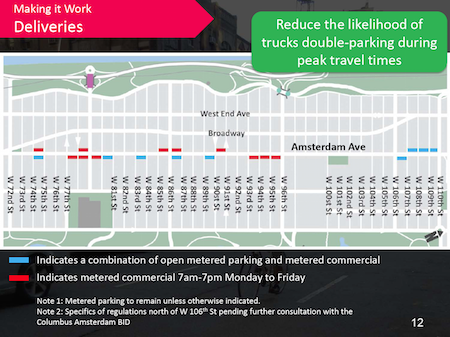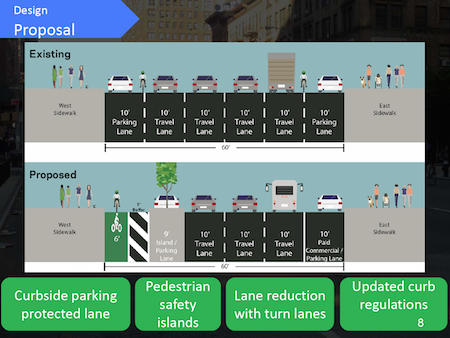
BY JACKSON CHEN | A plan for an Amsterdam Avenue bike lane has long been awaited by many, though apparently not all, with a revised proposal being met with a deadlocked vote at a January 12 meeting of Community Board 7’s Transportation Committee.
During the second visit by the city’s Department of Transportation to the committee to discuss a plan for Amsterdam Avenue, members ended the evening with a 4 to 4 tied vote. While some members emphasized the safety improvements a bike lane would deliver for all Upper West Side residents, others asserted that Amsterdam Avenue was not a suitable location for encouraging bike traffic.
DOT’s proposal was first introduced to the community during a November 10 Transportation Committee meeting. Responding to widespread neighborhood buzz around the desire for a northbound Amsterdam Avenue bike lane, the DOT presented plans that would incorporate a protected bike lane on the avenue from West 72nd Street to West 110th Street. In the plan, one of the avenue’s car traffic lanes would also be converted into a parking lane that would include left-turn bays and pedestrian islands, as well.
After garnering hours of community input at the November meeting, the DOT also went into the field and surveyed merchants and pedestrians on the 38-block Amsterdam Avenue stretch.
In its updated plan, the DOT focused its attention on delivery trucks that often double-park and render bike lanes useless, and even dangerous. Throughout the corridor, the DOT earmarked 11 locations — five on heavy-use locations of the west curb, six on the east curb — that would be metered commercial parking zones during weekdays. According to Margaret Forgione, DOT’s Manhattan borough commissioner, the zones would allow for a maximum of two hours parking before having to purchase more time.
DOT also included nine blocks that would be a combination of open metered parking and commercial zones, four of which are pending consultation with the Columbus Amsterdam Business Improvement District.
With the proposed bike lane passing two major cultural institutions, the DOT made specific arrangements for the streets around the Beacon Theatre and the Plaza Jewish Community Chapel.
Since the Beacon often uses its curb at the rear of the theater for equipment loading, the DOT proposed requiring that it employ temporary barriers to create a pseudo-protected bike lane to the east of the trucks when they are present.
As for the chapel, the DOT proposed banning left turns from Amsterdam Avenue onto West 91st Street and maintaining the existing no parking rules outside the main entrance.
Even with the changes the DOT made to its original plan presented in November, both co-chairs of CB7’s Transportation Committee and two other members voted against approving the agency’s Amsterdam Avenue proposal for multiple reasons.

Co-chair Andrew Albert said he is in support of a northbound bike lane and safety improvements on Amsterdam Avenue, but was hesitant to combine the two. Instead, Albert proposed that the DOT conduct a trial test of its current bike lane proposal to understand the feasibility and efficiency of the setup. DOT officials responded that they were not in favor of conducting such a test because it would take a significant effort to make sure the test is properly administered to yield meaningful results.
As for the other co-chair, Dan Zweig, he recommended the committee disapprove the proposal and instead ask the DOT to come up with an Amsterdam Avenue safety improvement proposal without a bicycle lane and an alternative northbound route.
The opponents’ suggestions for alternatives ranged from exploring Central Park West as a northbound bike lane to looking into a two-way bike lane on Columbus Avenue. DOT officials reiterated that Central Park West is too too narrow to incorporate a protected bike lane as long as it remains a two-way street. As for a two-way bike lane on Columbus, the agency said that was feasible, but that Amsterdam was the better choice based on its research.
According to Forgione, the Amsterdam Avenue proposal is a catchall to solve most of the corridor’s challenges.
“The advantage of the Amsterdam proposal is it addresses every issue and knocks out every concern all in one proposal,” Forgione said. “You have a northbound bike lane, and you’re also addressing pedestrian and vehicular traffic concerns at the same time. That’s why this is our favorite proposal.”
Much like the previous meeting in November, community members who turned out were largely in support of an Amsterdam bike lane, with few dissenting opinions, focused largely on parking concerns and reckless cyclists.
But with a split vote from the committee, the apparent popularity of the proposed bike lane has not yet held sway. The DOT proposal will now be brought to a vote during CB7’s full board meeting on February 2, according to the board’s chair, Elizabeth Caputo.
































